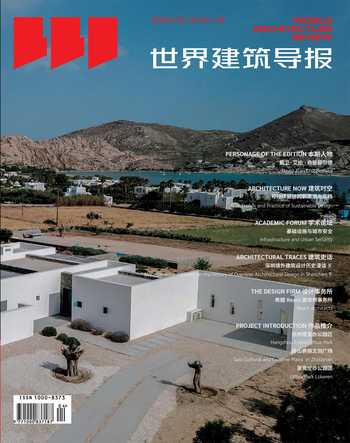“拥抱”别墅 希腊帕罗斯岛

设计单位:React建筑师事务所
主创建筑师:Natasha Deliyianni, Yiorgos Spiridonos
合作建筑师:Ioannis Kouzoumis
结构工程师:Christos Smyrnis
机电工程师:Nikos Chrystofyllakis
场地监管合作人:Ioannis Vagias
面积:150 平方米
项目年份:2017年
摄影师:George Messaritakis
Architects: React Architects
Architects in Charge: Natasha Deliyianni, Yiorgos Spiridonos
Collaborating Architect: Ioannis Kouzoumis
Structural Engineering: Christos Smyrnis
Mechanical & Electrical Engineering: Nikos Chrystofyllakis
Site Supervision Collaborator: Ioannis Vagias
Area: 150 m?
Year: 2017
Photographs: George Messaritakis
“拥抱是一种表达亲密的肢体语言,在人类文明社会中是通用的。拥抱就是两个或两个以上的人将手臂围绕在另一个人的脖子、后背或者腰部,紧紧相抱。”
该项目位于帕罗斯岛上的Aghios Ioannis Detis。场地的东边朝向大海,远处即为纳乌萨海湾。这片区域受特殊保护,且与Aghios Ioannis Detis 建造的环境公园相邻。
整个项目由两个单独体块组成,二者共用一片户外空间,其中包含一个游泳池。单个大体量建筑被分成两个,协同适应这片地形。两个体块均面向海景,二者之间的空间则打造成中央庭院,用以适应倾斜的场地和免受北风侵袭。
在场地西侧的至高点,两侧的砖石墙壁形成建筑的入口。小体量的建筑尽可能地适应基地的形态和坡度。最低目标要求是一个建筑体块就能承担保护区域的重量。免受强风侵袭的后院,通过直接引导人流进入建筑体量的核心空间来组织功能排布。這样的形式与修道院的空间形式如出一辙,后者周边为单个空间,中央则是礼拜堂。类似的空间排列还有传统的综合建筑‘katoikiés。
石墙围绕并且“拥抱”建筑,保护建筑不受人窥探。整个项目中,有的地方石墙与建筑相连成了建筑的墙体;有的地方则是利用石墙围合形成庭院,以适应场地和环境。只有在庭院内部才能看到建筑的抹灰白墙,路人只能看到部分立面。立面包括了围绕中央庭院的墙体;在这个方面实现了形式的可塑性,整合成统一的建筑方法。开口的设计结合了建筑的特色。主要以重复和标准化的特征为主。在场地边界上的开口则尽可能少。远处有小山坡的景色,因而侧重强调“第五立面”,即屋顶。
通过利用基克拉迪建筑的特点,我们设计了一系列的建筑和地形景观,以适应基克拉迪无水的条件,以期在环境中留下尽可能小的足迹。着眼于创造一种当代建筑语言的基克拉迪建筑形态特征的转变,以及与自然景观的融合,是设计的指导原则。
建筑师希望建筑的整体介入能够在与景观的对话中,创造一处宜居的空间。通过打破屋顶和室外空间的界限,创造空间和地域性的熟悉感,拥抱人类活动。
"A hug is a form of physical intimacy, universal in human communities, in which two or more people put their arms around the neck, back, or waist of one another and hold each other closely."
The work is situated at the Aghios Ioannis Detis location on the island of Paros. It has an eastwards orientation, with a view towards the sea and the Naoussa bay. The area is under a special protection order, and adjacent to it the Environmental Park of Aghios Ioannis Detis has been created.
The complex consists of two buildings with a shared open-air space and a swimming-pool. The large mass of a single building is broken down into two and is harmoniously adapted to the terrain. The masses are laid out facing the view, and the central courtyard has been created between them, adapted to the slope of the terrain and protected from the north winds.
The entrance is on the western side of the site, at its highest point, and has been inserted between the masonry buttressing walls. The buildings, of a small mass, are adapted as much as possible to the incline and topography of the terrain. A basic aim has been the least burdening with a building mass of the protected area. The courtyard at the rear, protected from the strong winds, organises the functions by creating a nucleus with direct reference to the building masses. Such forms are encountered in monasteries, which have the cells on the perimeter and the church in the centre. Similar arrangements are also to be found in traditional complexes of ‘katoikiés.
The stone walls encircle and ‘hug the building, protecting it from prying eyes. Ιn some places, the walls become a building, and in others, courtyards are created, adapted to the ground and to the environment. The plastered white walls of the buildings are visible only from the inner courtyard, and fragments of the elevations can be seen by the passer-by. The elevations consist of walls around the central courtyard; in this way plasticity of form is achieved, integrated into a unitary approach to architecture. The design of the apertures is combined with the architectural character of the building. The feature of the repetition and standardisation predominates. The apertures in the perimeter wall are as few as possible. Great emphasis is placed on the ‘fifth elevation, the roofs, as there are views from the hills round about.
By employing the features of Cycladic architecture, we have designed an ensemble of buildings and a landscaping of the terrain adapted to the waterless Cycladic conditions, with a view to leaving the smallest possible footprint on the environment. The transformation of the morphological features of Cycladic architecture with a view to creating a contemporary architectural language is, together with its integration into the natural landscape, the guiding principle of the design.
The totality of the intervention realised is in dialogue with the landscape and creates a space for habitation. Βy breaking down the boundaries between the roofed and open-air space, it embraces human activity in creating a familiarity with the space and the locality.

